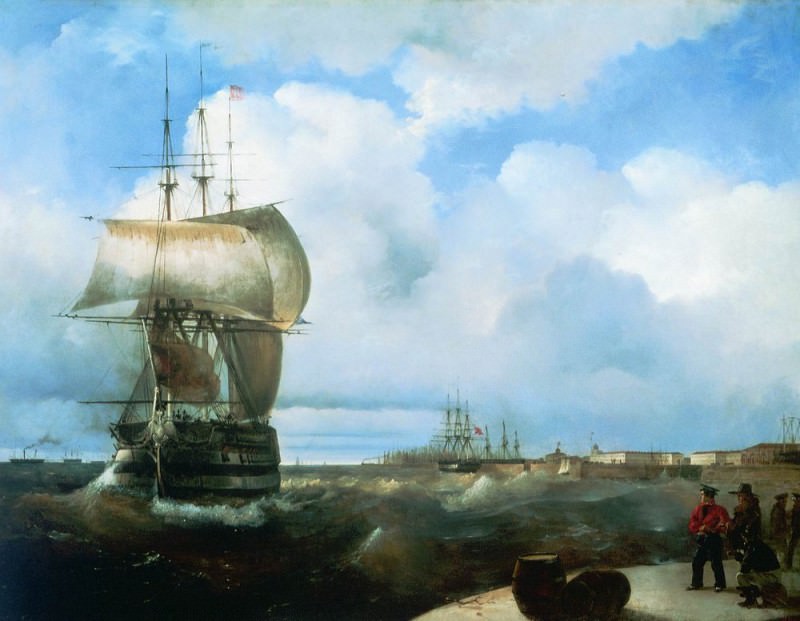From Saint Petersburg to Kronstadt by water  Automatic translate
Automatic translate
Saint Petersburg and Kronstadt are two cities closely connected by history, sea and transport. Kronstadt is located on Kotlin Island in the Gulf of Finland and is part of Saint Petersburg. This city has always been an important naval point of Russia, and today it has become a popular tourist destination.
One of the most convenient ways to get to Kronstadt, Strelna, Peterhof and the Oreshek Fortress from the center of St. Petersburg is by high-speed hydrofoils known as Meteors.
2 The modern route of the Meteor from St. Petersburg to Kronstadt
3 Features of the trip on the Meteor
4 What is interesting for tourists in Kronstadt
5 A special impression from the trip
History of water transport between St. Petersburg and Kronstadt
Kronstadt was founded by Peter the Great in 1704, almost simultaneously with St. Petersburg. From the very beginning, there was a need for regular communication by water between the two cities. The first ships were sailing and rowing boats that transported soldiers, workers and cargo for the construction of the fortress and the fleet.

In the 19th century, the first steamships appeared, which significantly accelerated transportation between St. Petersburg and Kronstadt. Regular steamship service was already established by the 1830s. The steamships were capacious and reliable, but their speed remained limited.
A real breakthrough occurred in Soviet times, when hydrofoils of the Meteor type appeared in the 1960s. These vessels could reach speeds of up to 65 km/h, which made it possible to cover the distance from the center of St. Petersburg to Kronstadt in about half an hour. The Meteors became a symbol of water transport in Leningrad and its environs.
During the Soviet period, the route was extremely popular among city residents and tourists. However, at the end of the 20th century, the popularity of this type of transport decreased due to economic difficulties. At the beginning of the 21st century, traffic on this route became more active again due to the development of tourism and interest in the history of the region.
Today, the route is served by modern ships equipped with comfortable salons with panoramic windows. They allow passengers to enjoy the views of the Neva, the Gulf of Finland and numerous attractions along the route.
The modern route of the Meteor from St. Petersburg to Kronstadt
The route starts from the pier next to the Palace Embankment in the center of St. Petersburg. From here, the Meteor moves along the Neva past the Peter and Paul Fortress, Vasilievsky Island and the Gazprom Arena stadium. Then the ship enters the waters of the Gulf of Finland and heads straight to Kotlin Island.
The journey usually takes from 30 to 40 minutes, depending on weather conditions. During the trip, passengers can see the panorama of the city from the water: the bridges of St. Petersburg, the famous Lakhta Center, port facilities and forts of the Gulf of Finland.
The Meteor arrives directly in the center of Kronstadt - to the pier at Petrovskaya Wharf. From here it is easy to walk to the main sights of the city.
Features of the trip on the Meteor
A trip on a hydrofoil boat differs from regular water transport in its speed and smoothness. These types of boats rise above the water surface thanks to special wings, which reduces pitching even in small waves.
On board the ship, passengers can comfortably sit in the saloon chairs with large windows to view the scenery. In good weather, you can go out onto the open deck and take photos.
Tickets are purchased in advance online or directly before departure at the pier. During the summer season, trips run regularly several times a day.
What is interesting for tourists in Kronstadt
Kronstadt attracts tourists with its rich history, architecture and maritime traditions. The city is a UNESCO World Heritage Site due to its unique monuments of fortification art.
Naval Cathedral of St. Nicholas the Wonderworker
The main architectural landmark of the city is the Naval Cathedral of St. Nicholas the Wonderworker. This majestic temple was built in the early 20th century in the neo-Byzantine style. Inside the cathedral, you can see mosaics, frescoes, and memorial plaques with the names of the sailors who died.
Forts of Kronstadt
There are numerous forts from the 18th and 19th centuries around the island: Fort Alexander I (Plague), Constantine, Milyutin and other defensive structures. Some of them are open for tourist excursions. Fort Alexander I is especially interesting for its unusual oval shape and the mysterious history of the plague laboratory.
Petrovsky Dock
The Petrovsky Dry Dock is a unique hydraulic engineering structure from the 18th century that has survived to this day almost unchanged. Ships of the Baltic Fleet were repaired here even under Peter the Great.
Monuments of the naval glory of Russia
The city has numerous monuments to outstanding Russian sailors: Admiral Makarov, Antarctic explorer Bellingshausen, as well as a monument to the blockade stickleback, a fish that saved many residents of Leningrad during the blockade.
City museums
Interesting museums to visit: Kronstadt History Museum, Tolbukhin Lighthouse Museum, open-air naval equipment exhibition. Models of ships, weapons from different eras and documents about the life of Baltic Fleet sailors are presented here.
Walking around the city
Kronstadt is convenient for walking: cozy streets with historical buildings of the 19th century are conducive to leisurely sightseeing. In the central square you can visit cafes or souvenir shops with a marine theme.
A special impression from the trip
Traveling on a high-speed vessel leaves vivid emotions thanks to the combination of speed and picturesque views of the Gulf of Finland. That is why meteors from St. Petersburg are deservedly popular among guests of the northern capital of Russia.
A visit to Kronstadt allows you to feel the connection between times: from the era of Peter the Great to the present day, this city remains a symbol of Russian naval glory.